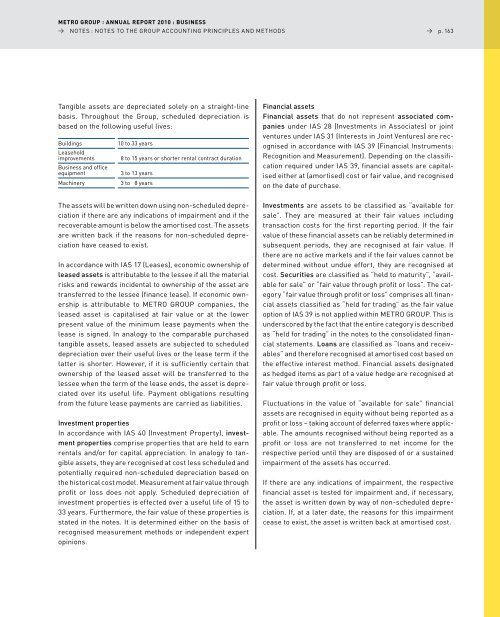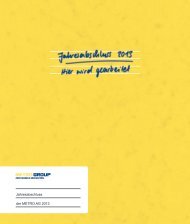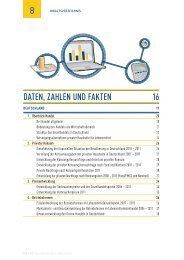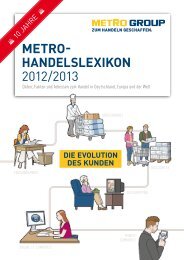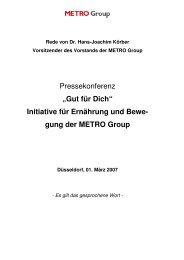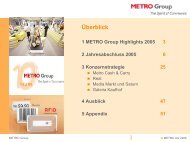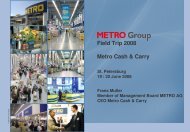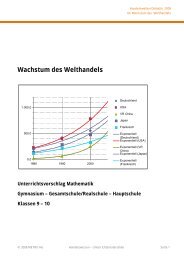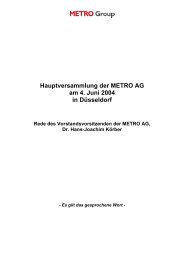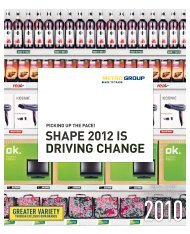pdf (2.5 MB) - METRO Group
pdf (2.5 MB) - METRO Group
pdf (2.5 MB) - METRO Group
You also want an ePaper? Increase the reach of your titles
YUMPU automatically turns print PDFs into web optimized ePapers that Google loves.
<strong>METRO</strong> GROUP : ANNUAL REPORT 2010 : BUSINESS<br />
→ NOTES : NOTES TO ThE GROuP ACCOuNTING PRINCIPlES ANd METhOdS<br />
Tangible assets are depreciated solely on a straight-line<br />
basis. Throughout the <strong>Group</strong>, scheduled depreciation is<br />
based on the following useful lives:<br />
Buildings 10 to 33 years<br />
leasehold<br />
improvements 8 to 15 years or shorter rental contract duration<br />
Business and office<br />
equipment 3 to 13 years<br />
Machinery 3 to 8 years<br />
The assets will be written down using non-scheduled depreciation<br />
if there are any indications of impairment and if the<br />
recoverable amount is below the amortised cost. The assets<br />
are written back if the reasons for non-scheduled depreciation<br />
have ceased to exist.<br />
In accordance with IAS 17 (leases), economic ownership of<br />
leased assets is attributable to the lessee if all the material<br />
risks and rewards incidental to ownership of the asset are<br />
transferred to the lessee (finance lease). If economic ownership<br />
is attributable to <strong>METRO</strong> GROuP companies, the<br />
leased asset is capitalised at fair value or at the lower<br />
present value of the minimum lease payments when the<br />
lease is signed. In analogy to the comparable purchased<br />
tangible assets, leased assets are subjected to scheduled<br />
depreciation over their useful lives or the lease term if the<br />
latter is shorter. however, if it is sufficiently certain that<br />
ownership of the leased asset will be transferred to the<br />
lessee when the term of the lease ends, the asset is depreciated<br />
over its useful life. Payment obligations resulting<br />
from the future lease payments are carried as liabilities.<br />
Investment properties<br />
In accordance with IAS 40 (Investment Property), investment<br />
properties comprise properties that are held to earn<br />
rentals and/or for capital appreciation. In analogy to tangible<br />
assets, they are recognised at cost less scheduled and<br />
potentially required non-scheduled depreciation based on<br />
the historical cost model. Measurement at fair value through<br />
profit or loss does not apply. Scheduled depreciation of<br />
investment properties is effected over a useful life of 15 to<br />
33 years. furthermore, the fair value of these properties is<br />
stated in the notes. It is determined either on the basis of<br />
recognised measurement methods or independent expert<br />
opinions.<br />
→ p. 163<br />
Financial assets<br />
Financial assets that do not represent associated companies<br />
under IAS 28 (Investments in Associates) or joint<br />
ventures under IAS 31 (Interests in Joint Ventures) are recognised<br />
in accordance with IAS 39 (financial Instruments:<br />
Recognition and Measurement). depending on the classification<br />
required under IAS 39, financial assets are capitalised<br />
either at (amortised) cost or fair value, and recognised<br />
on the date of purchase.<br />
Investments are assets to be classified as “available for<br />
sale”. They are measured at their fair values including<br />
transaction costs for the first reporting period. If the fair<br />
value of these financial assets can be reliably determined in<br />
subsequent periods, they are recognised at fair value. If<br />
there are no active markets and if the fair values cannot be<br />
determined without undue effort, they are recognised at<br />
cost. Securities are classified as “held to maturity”, “available<br />
for sale” or “fair value through profit or loss”. The category<br />
“fair value through profit or loss” comprises all financial<br />
assets classified as “held for trading” as the fair value<br />
option of IAS 39 is not applied within <strong>METRO</strong> GROuP. This is<br />
underscored by the fact that the entire category is described<br />
as “held for trading” in the notes to the consolidated financial<br />
statements. Loans are classified as “loans and receivables”<br />
and therefore recognised at amortised cost based on<br />
the effective interest method. financial assets designated<br />
as hedged items as part of a value hedge are recognised at<br />
fair value through profit or loss.<br />
fluctuations in the value of “available for sale” financial<br />
assets are recognised in equity without being reported as a<br />
profit or loss – taking account of deferred taxes where applicable.<br />
The amounts recognised without being reported as a<br />
profit or loss are not transferred to net income for the<br />
respective period until they are disposed of or a sustained<br />
impairment of the assets has occurred.<br />
If there are any indications of impairment, the respective<br />
financial asset is tested for impairment and, if necessary,<br />
the asset is written down by way of non-scheduled depreciation.<br />
If, at a later date, the reasons for this impairment<br />
cease to exist, the asset is written back at amortised cost.


